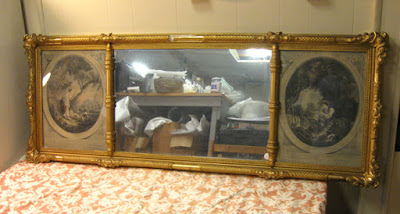Sometimes a project reveals information that, while not important or valuable, does at least liven up the day a bit.
When you need to work on an old frame or mirror, it is nice when you need to do a small repair without opening everything up. For bigger projects, you need to dismantle. This is primarily for ease of work (and minimizing risk too art or mirror plate. Sometimes you want to learn more, and need to look for clues inside.
 |
| Arrival in my elegantly appointed workshop |
First step was to remove the back panels.
 |
 |
| Museum accession label |
Pasted on the backboard is a Cincinnati Art Museum accession
label from 1945, showing source as the Marquise de Talleyrand.
 |
| Cardboard a sign that this mirror has been worked on since the 18th century |
When I turned them over - a theatrical surprise! Someone had
used theater posters. The Ruth Gordon poster was for a play from the 1944
season; the ballet was likely from 1950. So unless the workshop had a really
old stash of stuff, this mirror plate was probably replaced in the early 1950s.
 |
| Maybe the workshop was in the theater district? |
Will need to stabilize the gesso, and make any infills
needed. The rails are not carved, then gessoed, but instead the gesso is built
into a thick layer and then carved. Tedious work to be sure.
 |
 |
This is another one of my personal projects, so it will
probably be pretty low on the priority list. Don't expect to see an update on
the finished project any time soon, but at least now, without the glass it's a
lot easier to lift into its storage slot.





